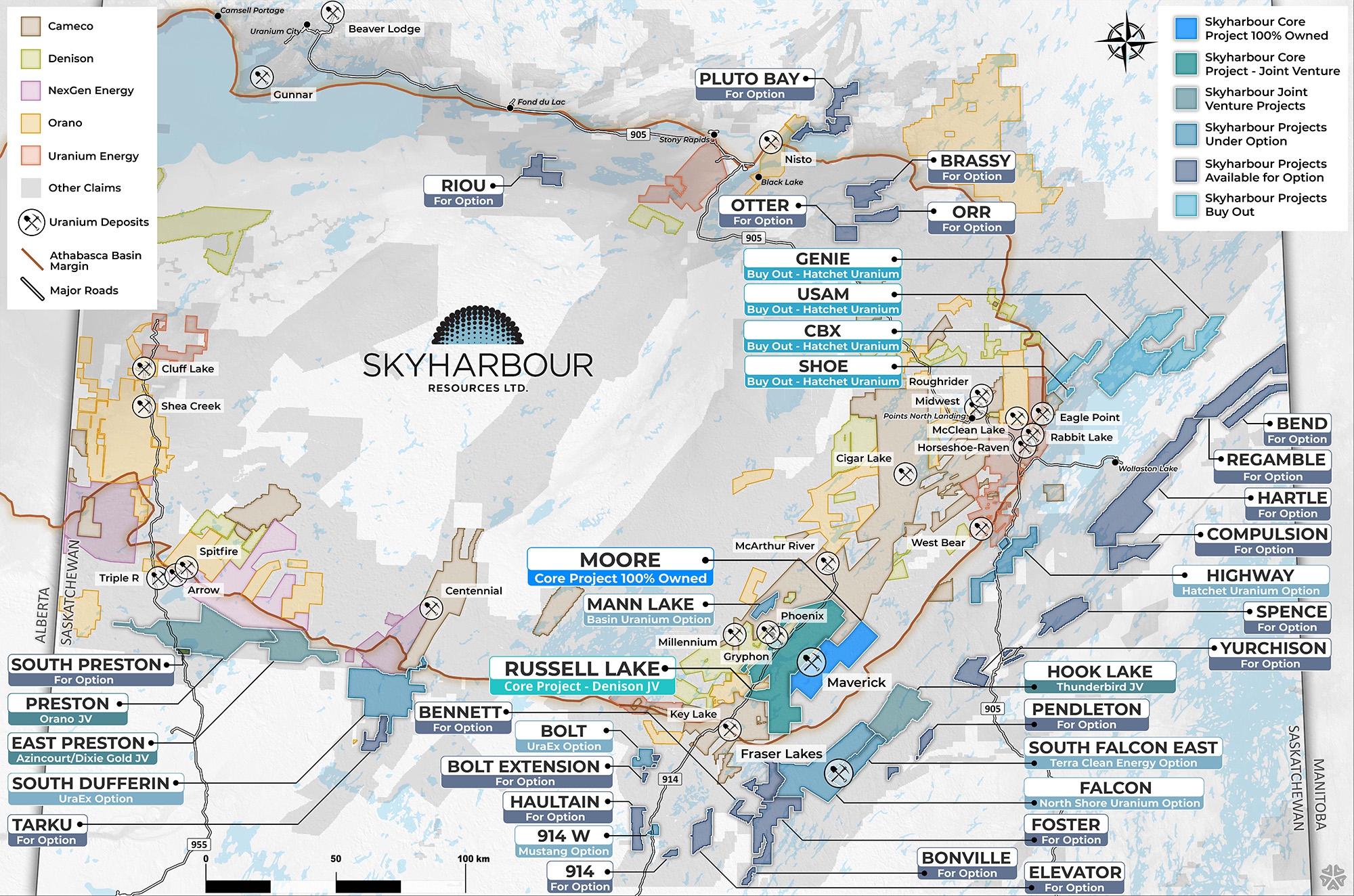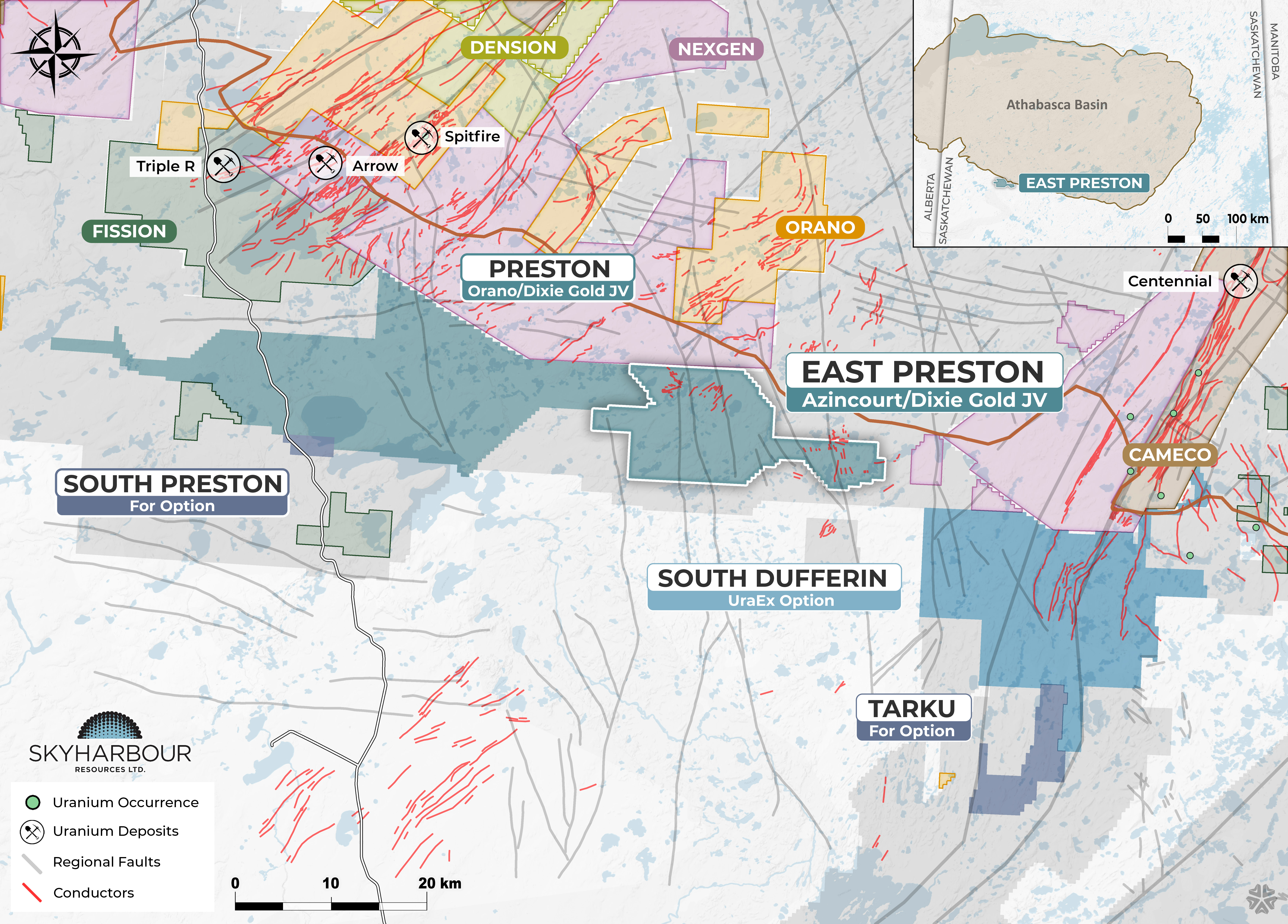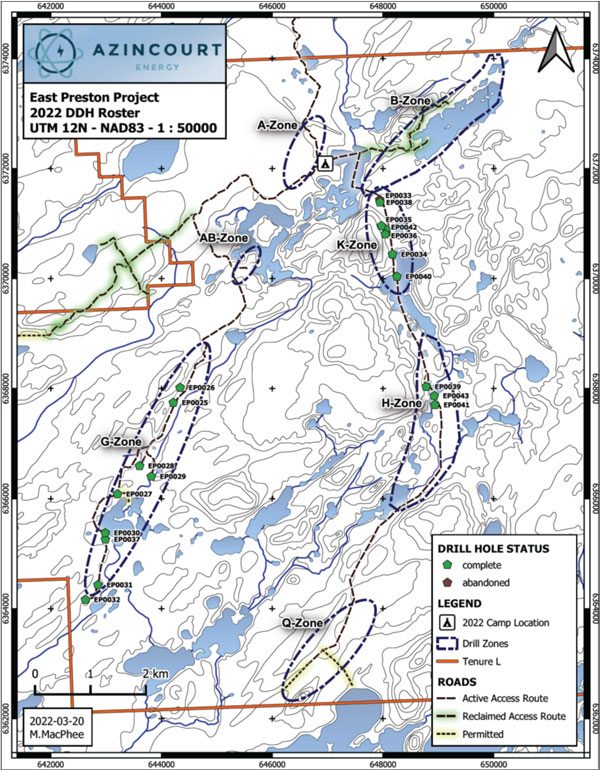Project Highlights:
- Large 20,674 hectare (51,080 acre) land position strategically located to the south of NexGen Energy's (TSX: NXE) Rook 1 project host to the high grade Arrow deposit, as well as proximal to Fission Uranium’s (TSX: FCU) Patterson Lake South (“PLS”) project host to the high grade Triple R deposit
- March 2017, Skyharbour signs option agreement with Azincourt Uranium (TSX-V: AAZ) to option 70% of a portion of the East Preston Project to Azincourt
- February 2021, Azincourt earned their interest in the project by completing CAD $2.5 million in staged exploration expenditures and making a total of CAD $1 million in cash payments over the previous four years as well as issuing a total of 9.5 million common shares of Azincourt divided evenly between Skyharbour and Dixie Gold
- Skyharbour has a 9.5% ownership in the East Preston Project, with Azincourt owning 85.8% and Dixie Gold owning the remaining 4.7%
- The winter 2024 drill program consisting of 1,086 metres of drilling in four diamond drill holes recently completed
Joint-Venture with Azincourt 85.8%:
March 2017, Skyharbour signs option agreement with Azincourt Uranium (TSX-V: AAZ) to option 70% of a portion of the East Preston Project to Azincourt.
February 2021, Azincourt earned their interest in the project by completing CAD $2.5 million in staged exploration expenditures and making a total of CAD $1 million in cash payments over the previous four years as well as issuing a total of 9.5 million common shares of Azincourt divided evenly between Skyharbour and Dixie Gold. Skyharbours current ownership of the East Preston Project is 9.5% with Dixie owning 4.7%.
2024 Winter Drill Program:
Azincourt recently completed the winter 2024 drill program, consisting of 1,086 meters of drilling in four diamond drill holes. The priority for the 2024 drill program was to follow up on the clay alteration zone and elevated uranium that was identified in the winter of 2023 with a focus on the area of transition between the K and H Zones.
A total of 53 geochemical samples were collected and sent to the Geoanalytical Laboratory at the Saskatchewan Research Council in Saskatoon, Saskatchewan for analysis. Final geochemical assay results are forthcoming. Samples of clay alteration were collected for analysis by Short Wavelength Infrared Reflectance (SWIR, sometimes referred to as “PIMA”) to confirm the clay species. 34 samples were collected from current drillholes with 20 samples also being collected from previous drill holes in an effort to better outline alteration halos and extents.
2023 Winter Drill Program:
August 17, 2023 - The priority of the winter 2023 drill program was to continue to evaluate the alteration zones and elevated uranium identified in the winter of 2022 with a focus on the G, K, H and Q Zones.
A total of 687 samples were collected throughout the program and sent to the Geoanalytical Laboratory at the Saskatchewan Research Council in Saskatoon, Saskatchewan for analysis. Analysis of the results shows uranium enrichment within the previously identified clay alteration zones along the K, and H- target zones. Uranium enrichment is identified as uranium (U) values and a uranium/thorium ratio (U/Th) above what would normally be expected in the given rock type or area.
Azincourt considers the drilling results to date to be significant, as major uranium discoveries in the Athabasca Basin such as McArthur River, Key Lake, and Millennium were primarily the result of drill testing of strong alteration zones related to conductor features. Identifying and upgrading the strong alteration zones is a significant step forward in identifying the key areas along the conductor trends where more attention is required.
2022 Drill Program:
July 13, 2022 - Drilling for the 2022 winter season at the East Preston Project resulted in 5,004.5 metres completed in 19 drill holes between January and March of 2022. Drilling during the program focused on the A-G and K-H-Q trends and commenced in the G-Zone where the 2021 drill program ended. A total of 420 samples were collected throughout the program and sent to the Geoanalytical Laboratory at the Saskatchewan Research Council in Saskatoon, Saskatchewan for analysis. After unexpected delays at the lab, results were finally received by TerraLogic Exploration in late June and immediately underwent a thorough quality control assessment prior to being accepted. An analysis of the results shows uranium enrichment within the previously identified alteration zones along the G-, K, and H- target zones. Uranium enrichment is identified as uranium (U) values and a uranium/thorium ratio (U/Th) above what would normally be expected in the given rock type or area.
Along the northeast trending G-Zone, extensive hydrothermal alteration, and evidence of east-west cross-cutting structures were highlighted in holes EP0030 and EP0037. The primary rock types in the alteration zone are granodiorite and diorite gneiss with average expected values of 2-3 ppm U and U/Th ratios of 0.25-0.3. A sample from Hole EP0037 returned 14.6 ppm U and a U/Th ratio of 1.5, five times the expected values. A sample from EP0032 returned 19.5 ppm U and a U/Th ratio of 0.8.
2021 Drill Program:
September 7, 2021 - The planned early fall diamond drilling program to complete approximately 1,000 meters of drilling remaining from the shortened winter 2021 program had been rescheduled after consultation with local communities and contractors. As a result, this meterage was used to further expand the upcoming extensive winter drill program. This program consisted of approximately 7,000 meters in 30-35 drill holes.
2012-2017 Southwest Athabasca Basin Uranium Discoveries:
- The Arrow discovery made by NexGen Energy (TSX-V: NXE); now the high grade Arrow deposit
- Patterson Lake South discovery made by Fission Uranium (TSX: FCU); now the high grade Triple R deposit
- Cameco / Orano (formerly AREVA) / Purepoint Uranium's Hook Lake Spitfire Zone high grade discovery
-
Three separate major discoveries in a short period of time in this emerging uranium district illustrate high grade nature of mineralization and potential for additional discoveries
The significant potential of the Western Athabasca Basin has been highlighted by recent discoveries in the area by NexGen Energy Ltd. (Arrow), Fission Uranium Corp. (Triple R) and a joint-venture consisting of Cameco Corporation, Orano (formerly AREVA) Resources Canada Inc. and Purepoint Uranium Group Inc. (Spitfire). In excess of $4.7-million in expenditures on the entire Preston Uranium Project have been incurred to date. This exploration has consisted of ground gravity, airborne and ground electromagnetics, radon, soil, silt, biogeochem, lake sediment, and geological mapping surveys, as well as two exploratory drill programs. Fifteen high-priority drill target areas associated with multiple prospective exploration corridors have been successfully delineated through this methodical, multiphased exploration initiative, which has culminated in an extensive, proprietary geological database for the project area.
Historical Exploration on the Properties:
An initial review of historic exploration data on the Preston Uranium Property has identified a number of potential areas for follow up. One high-priority area has clusters of anomalous uranium in lake sediment samples, anomalous uranium values in rock samples (up to 5.6 ppm U), and the presence of kilometre-scale northeast-southwest trending graphitic faults associated with sulphides and anomalous radioactivity as identified with scintillometers. A review of historic data has also identified a significant uranium in lake sediment anomaly in the western part of the Preston Uranium Property. A sample collected by the Geological Survey of Canada returned a value of 4.8 ppm U, considered to be significant in an area with a background uranium value of 1 ppm U. This high uranium value may indicate either the down-ice glacial transport of uranium boulders from source or an in-situ source of uranium. For comparison, the highest value down-ice from the Patterson Lake South discovery is 3.8 ppm U. Management cautions that past results or discoveries on proximate land are not necessarily indicative of the results that may be achieved on these properties.
Uranium mineralization in the Patterson Lake area bears a number of similarities to the high-grade uranium deposits in the Eastern part of the Athabasca Basin like those at the Cigar Lake and McArthur River mines. The mineralization occurs in structurally disrupted and strongly clay altered, commonly graphitic pelites and metapelites with narrow felsic segregations/pegmatites. Intervals of quartz-feldspar gneiss and semipelite are also present. Sulphides are commonly associated with mineralization along with anomalous levels of cobalt, nickel, molybdenum and boron. Uranium mineralization in the Patterson Lake area is also associated with felsic intrusives, primarily pegmatites. Skyharbour has both target types on its pre-existing properties and its recently acquired land in the Patterson Lake region.





